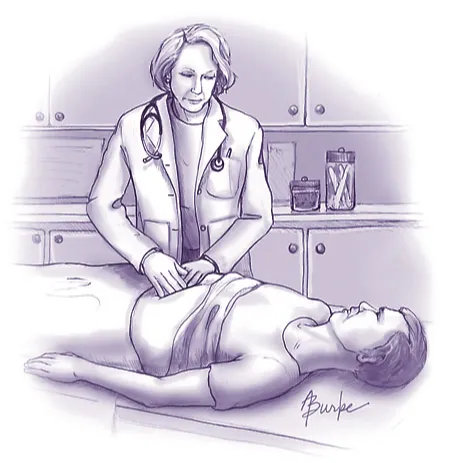Clinical Topics - Infections

The Elusive Lessons of Encephalitis Lethargica
Tags: autoimmune diseases clinical COVID-19 disease infection neurologist
Encephalitis Lethargica (EL) emerged as a deadly pandemic in the early 20th century, leaving many permanently disabled. Though rare today, its cause remains unknown. EL has two forms—dyskinetic (children) and Parkinsonian (adults). Researchers suspect links to influenza and COVID-19 due to shared neurological effects. Treatment is limited, and future viral pandemics could trigger EL’s return.
Read More →
Pyelonephritis: A Review of Literature
Tags: diagnosis infection kidney kidney infection literature review Pyelonephritis urinary tract infection UTI
Pyelonephritis needs to be diagnosed early so proper treatment can be instituted to prevent further complications. If urinary tract infection is left untreated, it can spread to the blood stream.
Read More →
A common link in the modifiable risk factors for severe COVID-19
Tags: coronavirus COVID-19
Certain comorbidities, such as hypertension and diabetes, are often diagnosed once a patient has been hospitalized with COVID. Current thought suggests that these people had the medical condition, but it was not diagnosed until they were hospitalized. In this article I offer a reason as to why that may be. Based on this perspective, I further stress the importance of health maintenance in disease prevention.
Read More →
Why Skin Tears Are a Big Deal
Tags: cellulitis dermatitis pressure ulcers reduced wound healing skin skin infections skin tears
Skin tears are the most common skin injury in the older population, but can occur in patients of all ages. It's important that clinicians are skilled at identifying individualized risk factors, interventions for prevention and the application of the most appropriate topical treatment.
Read More →
Ethical considerations for the mentally unwell in a global pandemic
Tags: coronavirus COVID-19 ethical principles ethical principles in nursing ethical standards ethical values ethics Mental Illness nursing ethics Pandemic
A case review on a mentally Ill patient during the COVID-19 pandemic.
Read More →
Case Study: A Systematic Approach to Early Recognition and Treatment of Sepsis
Tags: assessment Case Study emergency department guidelines mortality prevention risk factors sepsis standard of care treatment
The term sepsis is often misunderstood. The public and often healthcare workers are unaware of the severity and high mortality rates this infection process has upon the world. Sepsis has vague symptoms that make diagnosis difficult. Often, sepsis is diagnosed in the later stages, when more obvious yet severe symptoms occur. This case study discusses a female who presents to the emergency department with sepsis secondary to pneumonia. Over the course of three days, the patient’s health quickly deteriorates, demonstrating the rapid progression of sepsis. Clinical findings, such as vitals signs, lab abnormalities, and symptoms of sepsis are discussed. The term bundle of care is presented to educate the reader on the golden standard of care for treatment of sepsis. This case study intends to increase community awareness and education to health care providers as well as providing an evidenced-based treatment guideline. More education and raised awareness will help prevent a deadly yet treatable infectious process.
Read More →
A Deadly Virus Provides Lessons to Learn
Tags: coronavirus COVID-19 Lessons Learned
Like most of us, the COVID-19 virus has forever changed our lives. The virus is a wakeup call to reexamine life as we knew it; it is a chance for each of us to ask important questions such as, what makes us truly happy, what brings joy and peace in our lives and how can we make a positive difference in the lives of others.
Read More →
Who Will Be Left to Care for You?
Tags: acute care care coronavirus COVID-19 healthcare workers nurse workload nursing Pandemic
It is sadly too late to help many our front line healthcare workers who have contracted the deadly COVID-19 virus. We need to find a way to help the rest NOW in order to save their lives and in turn they can save your life.
Read More →
Crisis Management: Utilization of New Registered Nurses to Meet Healthcare Demands During COVID-19 Outbreak
Tags: coronavirus COVID-19 healthcare system
During the COVID-19 outbreak, healthcare institutions are forced to enter into crisis management mode as demands on our healthcare system increase. While there are many nurses and healthcare professionals on the frontlines of this pandemic, the growing needs of the public may soon overwhelm our healthcare system. Could the best way to ease the current burden be new graduate registered nurses?
Read More →
Knowing Sepsis
Tags: death end of life ICU sepsis
Sepsis is a major challenge in the hospitals, one of the leading causes of death, It must be diagnosed early so immediate treatment can be instituted.
Read More →
A Husband's Difficult Decision
Tags: bedside reporting end of life family Family Presence PACU sepsis
A husband's difficult decision regarding his critically ill wife and DNR status
Read More →
Clinical Considerations for Patients with Active Clostridium difficile Infection
Tags: Active Clostridium difficile Infection infection wound care
This article addresses the probable significant environmental Clostridium difficile (c. difficile) spore contamination that occurs when patients with active C. difficile infection are utilizing low air loss mattress therapy. We site published works that have proven environmental contamination exists in the absence of low air loss therapy. We assert that by virtue of the mechanism of action of low air loss surfaces, significantly increased environmental soiling is inevitable. Therefore, the risk of spreading infection is significantly increased. We are calling for additional research to determine the extent of increased contamination that occurs when low air low therapy is used on patients with active C difficile infection.
Read More →
Care of the Pediatric Patient
Tags: care nursing pediatric pediatric patients The Flu
Short exemplar about caring for a pediatric patient in Interventional Radiology
Read More →
Asymptomatic Bacteriuria: The Question for Treatment
Tags: adults asymptomatic bacteriuria diabetes guidelines risk factors screening
To improve the quality of care in patients with asymptomatic bacteriuria to promote safety.
Read More →
Influenza: Expert Advice You Need Now
Tags: advice child children emergency department Flu Influenza pediatrics The Flu
Among other advice for managing an influx of patients with possible flu, Dr. Whitley describes his experiences with clinical decisions such as which patients should be hospitalized and who can be safely managed at home during the ongoing influenza season. He also addresses the important issue of antiviral treatment and why he believes it is an essential component in the fight against influenza.
Read More →
To Gown or Not to Gown? For MRSA Prevention, That Is the Question.
Tags: cdc gown infection mrsa patient room prevention transmission
The Center for Disease Control (CDC) states that standard precautions should be used for all patients and should be enough to prevent the spread of most MRSA cases. However, in acute-care settings the CDC recommends additional contact precautions be implemented when there are ongoing MRSA transmissions, current infections, previous colonization, and in other special circumstances.
Read More →
Detour Off The Sepsis Road: Early Recognition is Key
Tags: advocacy Case Study death early recognition end of life health care ICU ICU Nurse patient outcomes Rapid Response RN RRT Nurse sepsis
At present, the US reports approximately 750,000 cases of sepsis a year and estimates 1 million cases by 2020 With a mortality rate of 30%, an estimated 250,000 annual deaths, and hospital costs exceeding $16 billion, sepsis has become a burden. It is imperative to increase the awareness and early recognition of sepsis.
Read More →Get Published for Free
Browse by Tag
advocate aging anesthesia behavior cardiac care Case Study child children clinical compassion COVID-19 critical care death diabetes disease education emergency department end of life ethical principles ethical values ethics future of nursing health health care ICU medication mental health nurse Nurse Education nursing nursing education nursing ethics nursing faculty nursing school nursing students PACU patient care patient outcomes patient safety pediatric poem profession risk factors stress student nurse students teaching therapy treatment
Most Popular Last Month
More from RN Journal
RN's informed about skills of Occupational Therapist & Physical Therapists
Pyelonephritis: A Review of Literature
Preventing Falls in the Elderly Long Term Care Facilities
Embracing Change
Why Do Nurses Eat Their Young?
Treatment of Subarachnoid Hemorrhage
Eating Disorder among Elderly Causing Heart Attack in Post Retirement Life
Understanding behaviors in Autism Spectrum Disorder
Yoga and the Benefits to Adults with Chronic Obstructive Pulmonary Disease









